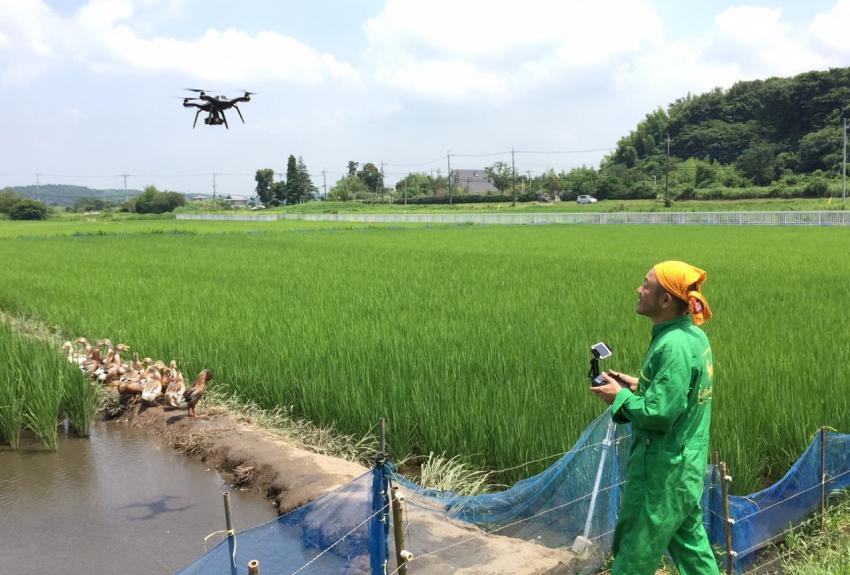Drones Are Changing The Face of Japan’s Rice Industry
Drones are proving to have a unique and valuable role to play in agriculture and this is particularly so in Japan, where an aging population and reluctance on the part of the younger generation to embrace farming has meant that the number of farmers is diminishing. New technologies such as drones are becoming a central part of agriculture and may mitigate this problem.
According to Japan’s Statistics Bureau of the Ministry of International Affairs and Communications, forestland and fields make up the largest percentage of the nation’s surface area—about 250,000 square kilometers or 67 percent. Another 50,000 square kilometers—or 12 percent—is used for agriculture, these areas cover nearly 80 percent of the country. Those aged 65 years and over have outnumbered the child population since 1997 The productive-age population (15–64 years) has been in decline since 1993, now totaling 76.56 million, or 60.3 percent.
In an article this week in Japan Today, three companies were the focus of the impact of drones on Japan’s rice industry. In 1983 at the request of the Japanese Ministry of Agriculture, Forestry and Fisheries, Japanese company Yamaha began developing pilotless drones and completed its first utility-use unmanned helicopter, the R-50, in 1987, widely used in spraying rice paddies. This technology in turn led to the R-MAX, an unmanned helicopter introduced in 1997. Brad Anderson, manager of Yamaha Motor Corporation USA’s Unmanned Systems Division says in the U.S. the initial target was vineyards, especially those on a difficult terrain. The similar topology suggests the technology can also be useful when applied to ricefields.

R-Max Unmanned Helicopter | Yamaha
Another product making headway in this area is OPTiM Corporation’s Agri Drone,the result of a three-way collaboration with Saga Prefecture and Saga University. Presented at last year’s Agri World 2017 Expo, OPTiM’s services work towards the common goal of modernising the agricultural industry in Saga, OPTiM aim to reduce labour and improve crop care through the use of drones.
According to Leslie James, OPTiM’s Tokyo Office, Agri Drone’s technology can be used to survey crops allowing farmers to “detect insects, pest damage, weeds, diseased plants, and mold”. Specialised features enable farmers to attach a pesticide bottle to the drone and spray only areas where insects are detected, reducing labour and the amount of chemicals used. It also has a chemical-free bug zapper attachment, which hangs from the drone as it flies low over crops allowing farmers to eliminate more than 50 common varieties of nocturnal pest.
This will be useful for eliminating pests which are particularly harmful to rice, such as the white-backed plant-hopper, and it is hoped that this technology will also be of benefit to other countries where rice is a critical component of the staple diet.
Drone Japan is also having a positive impact of Japan’s rice industry. According to Kiichiro Katsumata, president and chief operating officer of Drone Japan, the company’s Drone Rice Project has contracts with seven farmers to cultivate organic rice with the help of drones.
He says while drones are utilized for chemical spraying, they are gradually also being used for improving crop growth by using a multi-spectrum camera and a simple map to determine which areas of the crops are growing well.

Credit: Drone Japan
Katsumata believes this technology could be particularly helpful for farming methods which require more effort such as organic farming, which has an average yield of 50 percent less than what is harvested from chemically-treated rice. For example, drones can show organic farmers which areas need to be fertilized organically and Katsumata hopes to increase the number of farmers involved this year.
By comparison, Leslie James says the Agri Drone helps reduce labor for farmers; it takes photos of crops and the footage helps to show where problems lie so the farmer is then able to directly address the issue. Yamaha’s R-MAX provides an alternative to hand spraying, and the use of an unmanned helicopter is something Brad Anderson believes is financially viable to reduce labor pressure.
Both Yamaha and OPTiM say attracting a younger generation of farmers is an ongoing dilemma, but Anderson believes that the piloting of drones is a skill the younger generation finds attractive and could provide some benefit to the shrinking labour pool within agriculture. As he says, while many people do not have any interest in hand spraying a field, they may have interest in piloting an unmanned helicopter to do the spraying.
To that effect, OPTiM have an agreement with Saga University to encourage more students to major in agriculture and to stay in the area for farming after they graduate. James says they hope the new agriculture technology will make farming more attractive for young people. OPTiM is also working with local governments to help educate about the benefits of drone usage, and is working to enlist farmers to train in partnership with Fujieda City in Shizuoka and Obihiro City in Hokkaido Prefecture.
Partnerships have already been established through this campaign, including with a local bank, winery, herb farm, and farm management company, and it is hoped that crop yield will improve along with the value of the crops.
Katsumata also emphasises the importance of education and says, “sustainability with technology is inevitable and mandatory for the future—especially for the next generation of farmers. The Japanese Rice Project is about finding the Japanese traditional mind again, not just technology, selling, and agriculture and is an education for future farmers.”



















